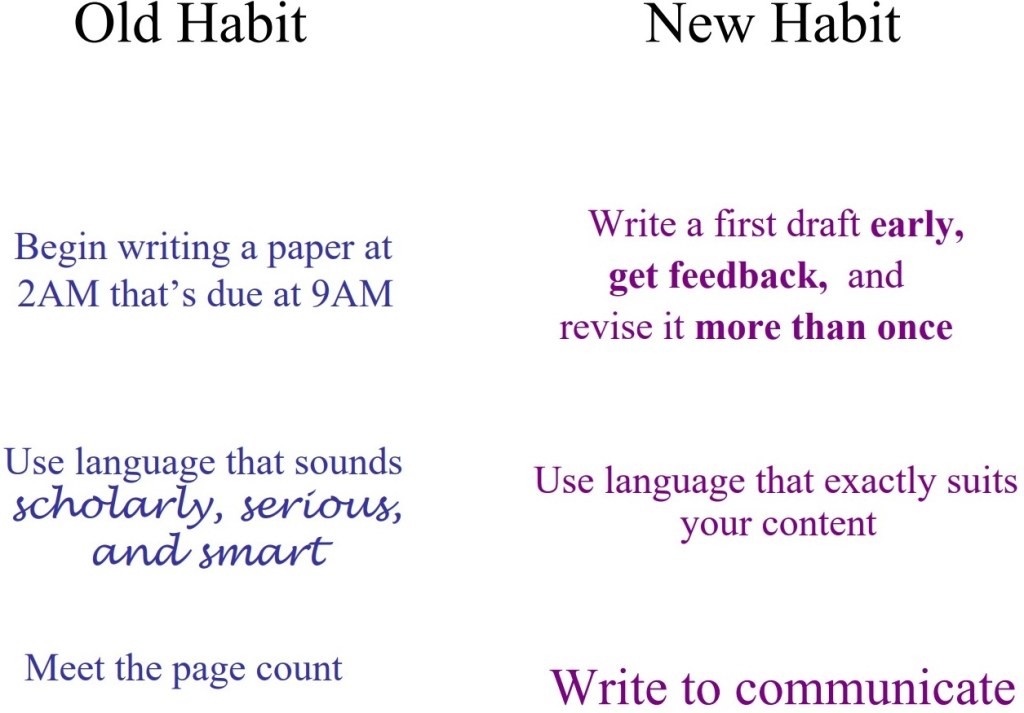By the Fancy Comma, LLC team
Stress less when writing with these five tips.
Tweet
The most difficult part of science (and social science) writing is the first part: getting started. That’s when you need to decide what to say and how to say it. This first step often doesn’t require a lot of writing, per se, just reflecting and strategizing. That’s why it often gets overlooked, which can lead to a lot of stress among people writing about science.

Scientists and social scientists don’t often get training in how to write about science, but Fancy Comma can help. We have free resources on our site relating to science writing, journalism, marketing, policy, and more. We also provide science writing mentoring services in addition to communicating science for our clients in the industry, academic, government, nonprofit, and other sectors.
The writing strategy and resources that work best for you depend on your topic, your audience, and your writing style. Keep reading for five tips from different resources you can use to get started on your next scientific writing piece, whether it’s a science essay for school, a journalism article, a blog post, or some other piece of scientific writing.
1. Don’t ignore the “pre-writing” step.
SUNY Brockport provides a step-by-step instructional guide for general research writing focused on both the research process and the writing process as dual processes. Their guide provides step-by-step instructions for research writing that apply to any field. As outlined there, the writing process starts with planning ahead, creating a schedule, drawing inspiration, and coming up with a thesis.
Do you account for pre-writing in your essay writing endeavors? Set aside time to do these pre-writing steps. Check out this student blog at MIT in which Cami M. outlines the steps she takes to write a research paper. Most of her blog is dedicated to just finding and evaluating sources.
2. Learn how to write a lay summary.
When stressing, it’s always good to keep things simple. Starting out with the basics can be a good way to build an essay or thesis. One way to do that is by learning how to write a lay summary, which is a short summary of research meant for a general audience. Lay summaries can be useful not only when communicating science to the public but to communicate more clearly both within and outside of one’s academic field. Monica Duke of the Digital Curation Centre in Scotland wrote a guide to writing a lay summary. Read and download Duke’s lay summary explainer.
3. Tell a story.
The human brain is wired for stories. There’s a reason that certain stories have persisted for centuries. Think of your writing as a story. Even if you’re writing about science research, you can still tell a story. Purdue Online Writing Lab, in their guide to writing experimental psychology papers, suggests asking yourself the following questions before you start writing:
- What story do you want to tell?
- What literature best speaks to that story?
- How do your results tell the story?
- How can you discuss the story in broad terms?
Coming up with an overall story gives your writing a framework, and if you can fit everything into that framework, you’ve done one of the most difficult parts of the writing process, which is getting started.
4. Break up your work into smaller, more manageable pieces.
A literature review is a type of academic paper that summarizes all of the current thought on a given topic in a given field. As such, writing a literature review may involve reading tens or even hundreds of articles, synthesizing the information and looking for patterns and trends, and coming up with new insights from the total sum of these articles. As such, it can be daunting to work on a literature review. That’s where planning and time management becomes key. Luckily, the University of North Carolina in Charlotte has come up with a helpful guide on how to get started with literature reviews. Check it out here. While the guide is specific to political science, it applies to all types of research writing.
Not writing a review? Consider coming up with a game plan in which you break up the writing process into more manageable tasks. Refer back to #1 in this blog about setting aside time for pre-writing – things like research, brainstorming, and outlining. Yes, this can include things such as setting aside an hour or two to search Google Scholar and see what people have written on your subject, just to get an idea of what’s out there. Don’t forget to set aside some time for writing, too, of course.
5. Work on your writing style.
Writing is a craft. That means that it is a skill that can be improved with experience, like driving or playing an instrument. One aspect of writing beyond simply reporting your research and results is style. Stylistic aspects of writing are typically not taught in science courses, but that doesn’t mean they’re not important. The MIT Biological Engineering program has a page dedicated to scientific writing which discusses stylistic aspects also.
Follow these tips to start your next scientific paper feeling strategic rather than stressed. Check out our other writing tips and tricks here.
One thought on “5 Ways to Stress Less When Starting a Scientific Writing Piece”